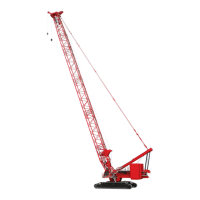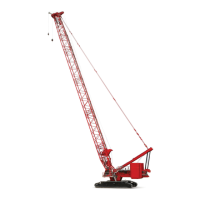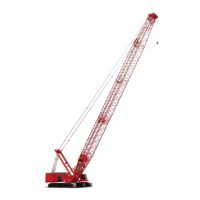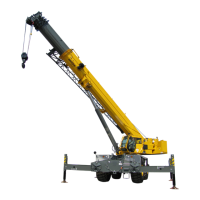SAFETY INFORMATION MLC650 VPC-MAX™ OPERATOR MANUAL
2-14
Published 04-06-18, Control # 231-14
5. For cranes produced before 2003, Rated Capacity
Indicators/Limiters were not required by ASME B30.5 for
non-personnel lifting.
To aid the operator in staying within the crane's Capacity
Chart with the total applied load, Manitowoc
recommends that its cranes be equipped with Rated
Capacity Indicators/Limiters to monitor the load on each
load line.
Operator is still responsible for knowing load and
radius whether or not the crane is equipped with
load indicator(s).
6. Manitowoc recommends that each load line be equipped
with an anti two-block device.
7. Manitowoc’s Capacity Charts are based on freely
suspended loads. To prevent side load damage to the
boom, jib, and sheaves:
• The load lines must hang as close to vertical as
possible to minimize side and forward loads.
• The distance between the load points and the hook
points must be a minimum of three times the
horizontal distance between the hook point on the
load being lifted.
• The load must remain centered on the boom and jib
point shafts unless special lift approval is granted by
Manitowoc.
• The load lines should be located over the load’s
center of gravity as it is supported on a trailer, a
barge, or the ground.
8. The crane operator shall be familiar with the operational
characteristic of the crane as it relates to multiple drum
operation (simultaneous operation, same or opposite
direction, or individual operation).
9. When using tandem drums, the maximum operating
layers may be limited depending on whether the crane
was initially designed for tandem drum operation or not.
10. Load shift when lifting with two hooks may be more
unpredictable than typical one hook lifting.
Holding Load
When a load is suspended, the operator shall take the
following precautions:
1. Not leave his/her position at the controls
2. Not allow personnel to stand or pass under the load
3. Move all controls to off, apply all drum brakes, engage
the boom hoist pawl, and apply the swing and travel
brakes or locks.
SIGNALS
1. Continuous communication must be maintained
between the operator and the signal person during all
crane movements. If communication is disrupted,
operator shall stop all crane movements.
2. Signals to the operator must be in accordance with the
standard signals shown in Section 3, unless
communications equipment (telephone, radio, etc.) is
used.
3. All signals must be easily understood by the operator at
all times. The operator shall not respond to any signal
which is not clearly understood.
4. For operations not covered in the standard signals, or for
special situations or emergencies, additional signals
may be required. In those cases, the signals used must
be agreed upon in advance by the operator and the
signal person. The signals used must not conflict with or
have potential to be confused with the standard signals.
5. When it is necessary to give instructions to the operator
(other than those established by the signal system), all
crane motions must be stopped.
6. The signal person shall:
a. Be tested by a designated person and show that he
or she has a basic understanding of crane
operations and limitations, to include boom
deflection
b. Be thoroughly familiar with the standard hand
signals and voice signals if used
c. Be positioned in clear view of the operator. The
signal person’s position should give him or her a
clear view of the load, the crane, and the operating
area.
d. Direct the load so it does not pass over personnel.
e. Keep unnecessary personnel out of the crane’s
operating area.
7. When moving the crane, the following audible signals
must be used:
a. STOP - one short audible signal
b. GO AHEAD - two short audible signals
c. BACK UP - three short audible signals

